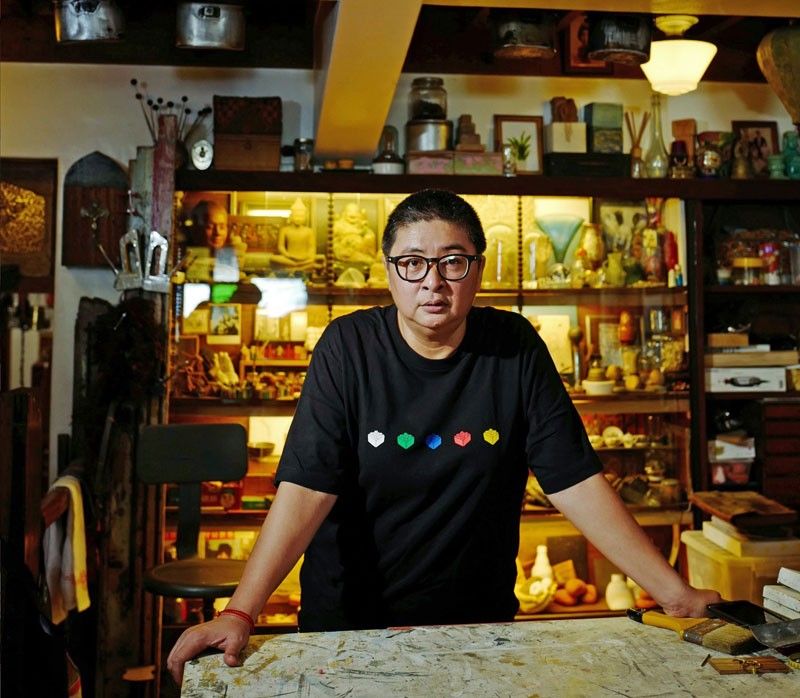Christina Quisumbing Ramilo: Making it

MANILA, Philippines — There’s poetry to this,” begins Christina Quisumbing Ramilo, known in the art world simply as “Ling.” She refers to the process of gathering materials for her art works, usually found objects that people have discarded but for her still have significant value as bearers of story and history. She repurposes these materials and transforms them into sculptures, assemblages, or installations — a towering cone of dental casts, a tapestry of used sand paper, a chair made of clutches.
Despite the undeniable sculptural quality of her work, Ramilo doesn’t call herself a sculptor. “I do very minimal sculpting,” she says. “I make objects, I arrange objects until they make sense to me.” Usually site-specific, her works reveal a deliberate clumsiness, a shot of humor. One can still make out the constituent parts of her work and what may be referred to as their “bruise of use” — the places that bear the brunt of human contact.
Her works are also redolent with a sense of incompleteness. “I don’t like finished works,” she admits. Her intervention into the material is minimal, largely concerned with smoothing out the surface. “I have works that look raw, but when you touch them, they are smooth. I don’t like (the surface) so polished, not literally shiny, but it feels good to touch — very tactile…but you still feel the lumps, the humanity, the imperfections.”
These traits are what she hopes to convey to viewers seeing her special exhibition at Art Fair Philippines. Titled “Forest for the Trees,” it is composed of an installation that features different scraps of wood long discarded from either renovated or demolished houses. Measuring 12 meters across, it is one of her largest and most ambitious as the scraps of wood come from different sources — from her ancestral house in Quezon City whose renovation she oversaw years ago to the storied houses of Las Casas Filipinas de Acuzar.
Ramilo envisions “Forest for the Trees” as a veritable “bibliotheque,” an archive of architectural remnants for all the world to see — and touch. By extension, each scrap of wood functions as a metaphorical book, which contains its own collection of information. These “books” are annotated and organized with a system in mind, just like in a library, so the viewer may gain access to their respective origin, history, and context.
Most of Ramilo’s works takes time to get finished, including this recent showcase. For comparison, a similar work, though smaller than the one featured in the Art Fair, took 10 years to complete. This means that most of her projects are a result of assiduous collecting, coming into fruition only when she has gathered enough material. While she can simply scour the metropolis and be on the lookout for beams and posts sold in junk shops, that for her would circumvent her own creative process and go against the qualities she cherishes: the slow burn, the familiarity of where the materials came from, the intimacy with those materials.
Which means that part and parcel of Ramilo’s artistic philosophy is time — how it is embodied, expressed, and extended by objects. Hence, her deep respect for the integrity of the material. “I don’t like altering materials,” she says. “I don’t intervene as much as possible. I like that my use of materials is authentic. So, I work with the limitations of what I find.” By so doing, Ramilo underscores that the beauty of these materials lies precisely in the secret life they carry, which the artist exposes as tangible truth.
Ramilo has always worked with wood. Her attraction to the material, aside from it being organic, is how it invisibly weaves through our spaces and everyday lives, bearing the weight of structures or providing adornment, darkening and gathering the patina of history. Arranged in the context of “Forest for the Trees,” these pieces of wood become the visible proof of the lives they once contained, the remaining evidence of former habitations.
As people may have different relationships and engagements with the installation, Ramilo acknowledges that “Forest for the Trees” offers a multitude of readings. “It’s simple and straightforward but not quite, because it can be many things,” she says. “It’s about the environment, it’s about lost histories, it’s about accumulation, consumption, waste, time.” In its welter of ambiguities, the work speaks volumes.



















